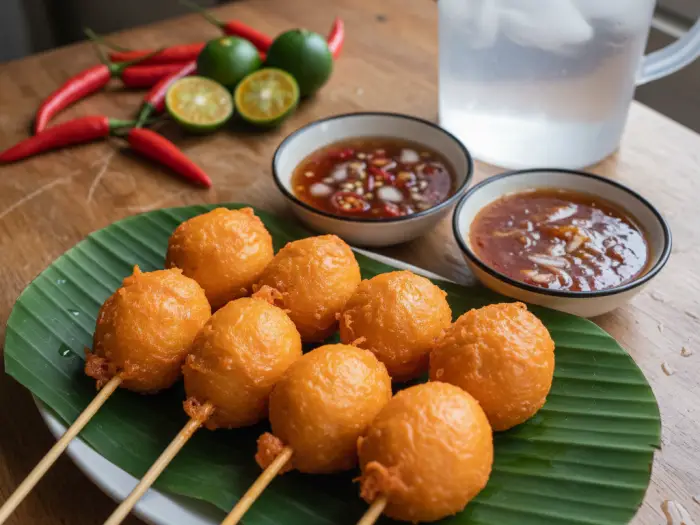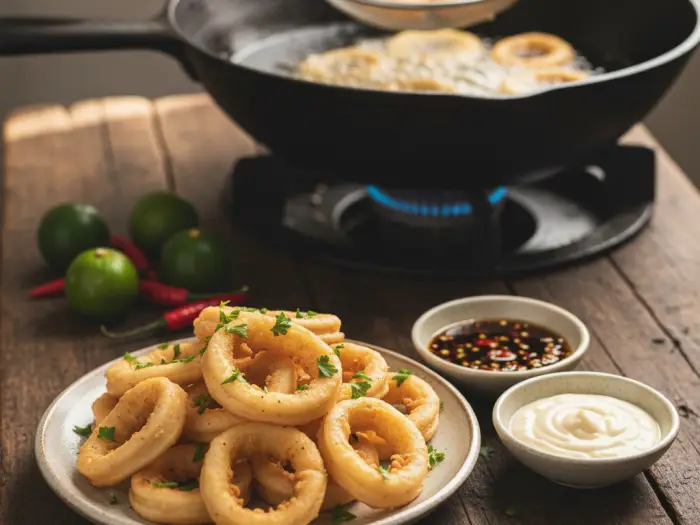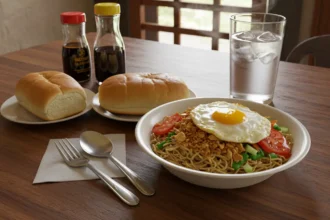There’s nothing quite like the sound of “Tahooo!” echoing in the morning streets, or the sight of a fishball cart glowing under a yellow bulb at dusk. Filipino street foods aren’t just merienda – they are a whole mood, a piece of Filipino life you can taste.
- 🍢 1. Fishballs and Manong’s Sauce
- 🥚 2. Kwek-Kwek (Orange Quail Egg Fritters)
- 🍢 3. Isaw (Grilled Chicken Intestines)
- 🥤 4. Taho (Silken Tofu with Arnibal and Sago)
- 🍧 5. Ice Scramble (Iskrambol)
- 🍌 6. Banana Cue and Turon
- 🦑 7. Calamares (Fried Squid Rings)
- ❓ FAQs About DIY Filipino Street Foods
- 🎉 Bring the Kanto Vibes Into Your Kitchen
- 🧭 References
But let’s be real. Sometimes you’re craving kwek-kwek at midnight.. or maybe you’re an OFW abroad, dreaming of isaw while stuck in a different timezone. And yet, no manong cart in sight. Sad?! Doesn’t have to be.
This guide is your ticket to bring the kanto street food experience right into your own kitchen. From fishballs swimming in sweet-and-spicy sauce to taho layered with sago and arnibal, we’ll walk through 7 classic Pinoy street foods you can DIY at home. They’re easier than you think, masarap for the whole family, and honestly, a fun weekend project. Street vibes, minus the dust and traffic.

🍢 1. Fishballs and Manong’s Sauce
If there’s a king of Pinoy street food, it’s the humble fishball. Crispy outside, chewy inside, skewered with a stick, and dunked in that legendary manong sauce – sweet, garlicky, sometimes spicy, sometimes vinegary. The ball is the vessel, but the sauce.. that’s the soul.
Ingredients (Fishballs)
- 1 pack frozen fishballs (available in wet markets, supermarkets, or Asian stores abroad)
- Cooking oil, for deep frying
(Optional if you want homemade fishballs)
- 500g galunggong or any white fish, filleted
- ½ cup cornstarch
- 2 tbsp all-purpose flour
- 1 egg white
- 1 tsp salt & pepper
Ingredients (Classic Manong’s Sauce – Sweet Style)
- 2 cups water
- 3 tbsp soy sauce
- 5 tbsp brown sugar
- 1 tbsp cornstarch (dissolved in 2 tbsp water)
- 1 tbsp garlic, minced
- ½ tsp ground black pepper
- 1–2 tbsp vinegar (adjust to taste)
- 1–2 siling labuyo, chopped (optional, for spicy kick)
Instructions
- Cook the Fishballs: Heat oil in a deep pan or wok. Drop in frozen fishballs (or homemade ones). Fry until they puff up and turn light golden brown. Drain on paper towels.
- Make the Sauce: In a saucepan, combine water, soy sauce, brown sugar, garlic, pepper, and vinegar. Bring to a simmer.
- Stir in the cornstarch slurry slowly, whisking until the sauce thickens to a syrupy consistency.
- Adjust Flavor: Taste-test and tweak – sweeter? Add sugar. More bite? Extra suka. Spicy? Toss in siling labuyo.
- Serve Street-Style: Pour sauce into small jars or bowls. Skewer fishballs, dip, and enjoy like you’re standing by a cart on the kanto.
Tips & Hacks
- Want variety? Make 2–3 sauces: one sweet, one spicy, one vinegar-based with onions and chili – just like manong’s cart.
- If making homemade fishballs, chill the mixture before frying to firm up the texture.
- Pair with kikiam or squid balls for the full street food spread.

🥚 2. Kwek-Kwek (Orange Quail Egg Fritters)
Bright orange, crispy outside, soft and creamy inside – kwek-kwek is the Pinoy street snack you spot from a mile away. The secret? That annatto-colored batter that makes the eggs pop like little golden suns. And whether you dip in sweet sauce or spiced suka, it’s always sarap.
Ingredients
- 15–20 quail eggs (itlog ng pugo), boiled and peeled
- 1 cup all-purpose flour
- ½ cup cornstarch
- 1 tsp baking powder
- 1 tsp salt
- 1 tsp annatto (atsuete) powder, dissolved in ¼ cup warm water (for the orange color)
- ¾ cup cold water (adjust as needed)
- Cooking oil, for deep frying
Optional:
- Small chicken eggs (tokneneng version) if quail eggs aren’t available
Instructions
- Boil the Eggs: Place quail eggs in boiling water for about 5 minutes. Let cool, then peel carefully.
- Make the Batter: In a mixing bowl, combine flour, cornstarch, baking powder, salt, annatto water, and cold water. Whisk until smooth. The batter should be thick enough to coat eggs evenly.
- Coat & Fry: Heat oil in a deep pan. Roll each egg in flour lightly (so batter sticks), then dip into the batter. Carefully drop coated eggs into hot oil.
- Cook Until Golden: Fry in batches, turning occasionally, until crispy and deep orange. Drain on paper towels.
- Serve Street-Style: Stick a few on barbecue skewers and serve with sweet fishball sauce or spicy vinegar dip.
Tips & Hacks
- For crunchier kwek-kwek, double-dip: coat once, fry lightly, dip again, and fry until golden.
- No annatto? A pinch of turmeric or orange food color works in a pinch.
- Tokneneng (big egg version) is perfect as a heavier snack – same process, just longer fry time.

🍢 3. Isaw (Grilled Chicken Intestines)
The smoky smell of isaw on the grill? That’s pure street food nostalgia. Skewered chicken intestines basted in sweet-savory marinade, eaten fresh off the ihawan with suka dip – nothing says kanto BBQ like this. Yes, you can make it at home (promise).
Ingredients
- 500g fresh chicken intestines (from wet market)
- 1 tbsp salt
- ½ cup vinegar (for cleaning)
- 3–4 cups water (for boiling)
- 2 slices ginger
- 2 bay leaves
For the Marinade/Basting Sauce:
- ½ cup banana ketchup
- 3 tbsp vinegar
- 2 tbsp calamansi juice (or lemon)
- 2 tbsp soy sauce
- 3 tbsp brown sugar
- 3 cloves garlic, minced
- 1 tsp ground black pepper
For Serving:
- Spiced suka dip (vinegar + onions + chili)
Instructions
- Clean the Intestines: Wash intestines thoroughly with water, scrubbing with salt and vinegar until smell is reduced. Rinse well.
- Pre-Boil: In a pot, boil intestines with water, ginger, and bay leaves for 15–20 minutes. This tenderizes and removes odor. Drain and cool.
- Marinate: In a bowl, mix ketchup, vinegar, calamansi, soy sauce, sugar, garlic, and pepper. Add boiled intestines and marinate for at least 1–2 hours (overnight is better).
- Skewer: Thread intestines onto bamboo sticks in a zigzag pattern (classic isaw look).
- Grill: Cook over hot charcoal or broil in oven, basting occasionally with leftover marinade, until slightly charred and glossy.
- Serve Street-Style: Best eaten hot, with a bowl of spiced suka for dipping.
Tips & Hacks
- For extra smoky flavor, brush skewers with a little oil mixed with ketchup while grilling.
- Don’t want to deal with intestines? Use the same marinade for pork BBQ or chicken skewers – classic Pinoy BBQ taste without the cleaning hassle.
- If abroad and no isaw in sight, try chicken skin or liver – works with the same marinade.

🥤 4. Taho (Silken Tofu with Arnibal and Sago)
“Tahooo!” – that morning call hits different. And if there’s no magtataho passing by, don’t worry.. you can bring the same comfort to your own kitchen. Warm silken tofu, sweet arnibal syrup, and chewy sago pearls layered in a cup – a taste of Pinoy mornings in every spoonful.
Ingredients
- 500g silken tofu (store-bought or homemade)
- 1 cup small sago pearls
- 1 ½ cups brown sugar
- 1 ½ cups water
- 1 tsp vanilla or banana essence
Instructions
- Cook the Sago: Boil sago pearls in plenty of water until translucent (about 30–40 mins). Drain and soak in water until ready to use.
- Make the Arnibal Syrup: In a saucepan, combine brown sugar and water. Simmer until thick and syrupy, about 8–10 mins. Stir in vanilla or banana essence.
- Warm the Tofu: Gently steam silken tofu for 5–10 minutes, or microwave briefly until warm but still delicate.
- Assemble: In a cup or glass, layer a scoop of tofu, spoonfuls of sago, and a drizzle of arnibal. Repeat to fill the cup.
- Serve Street-Style: Hand it over with a plastic spoon (for nostalgia) or sip straight from the cup.
Tips & Hacks
- For smoother texture, strain tofu with cheesecloth before steaming.
- Adjust syrup sweetness to your taste – some like it super matamis, others just lightly sweet.
- Abroad? Asian stores often carry silken tofu and tapioca pearls (sago alternative).

🍧 5. Ice Scramble (Iskrambol)
Remember running to the pink cart after school?! Iskrambol was the Pinoy kid’s answer to halo-halo – sweet, colorful, topped with powdered milk and sprinkles. The good news: you don’t need the cart.. you can make it in your blender at home.
Ingredients
- 4 cups shaved ice (or finely crushed ice using blender/processor)
- ½ cup evaporated milk
- ¼ cup condensed milk (optional, for sweeter version)
- ¼ cup sugar (adjust to taste)
- 1 tsp banana or strawberry flavoring (powdered juice mix works)
- Few drops pink/red food coloring
Toppings (choose your favorites):
- ½ cup powdered milk
- Chocolate syrup or Milo powder
- Mini marshmallows
- Candy sprinkles
Instructions
- Prepare the Ice: Shave or crush ice until fine and slushy.
- Mix Base: In a large bowl, combine ice with evaporated milk, condensed milk, sugar, flavoring, and food coloring. Mix until evenly pink and creamy.
- Scoop into Cups: Divide mixture into plastic cups or bowls.
- Top It Off: Sprinkle with powdered milk, drizzle chocolate syrup, and add marshmallows or sprinkles for the full iskrambol effect.
- Serve Immediately: Best enjoyed cold and messy, just like the street version.
Tips & Hacks
- For smoother texture, blend ice with a little water or milk.
- No flavoring? Try strawberry Nesquik or Tang for the pink base.
- Keep extra toppings in small jars so kids (or adults) can decorate their own cups.
🍌 6. Banana Cue and Turon
Afternoon merienda on the street? You’ll almost always see skewered banana cue glistening in caramelized sugar or crispy golden turon fresh out of the kawali. Sweet, simple, and so very Pinoy. The good news? Both are ridiculously easy to make at home.

Banana Cue
Ingredients
- 6 ripe but firm saba bananas
- ½ cup brown sugar
- 2–3 cups cooking oil (for deep frying)
- Bamboo skewers (optional, for street-style serving)
Instructions
- Heat Oil: In a deep pan, heat oil until hot but not smoking.
- Caramelize: Add brown sugar directly into the oil. Let it melt and bubble slightly.
- Fry Bananas: Carefully drop saba bananas into the hot oil. Fry while turning until coated with caramelized sugar and golden brown.
- Skewer & Serve: Drain briefly on paper towels, then stick 2–3 bananas per skewer for the authentic street look.
Tips & Hacks
- Use ripe saba that’s firm, not mushy.
- For extra crunch, sprinkle sugar again while bananas are still hot.

Turon
Ingredients
- 6 ripe saba bananas, sliced into halves or quarters
- 6 strips ripe jackfruit (langka)
- 6–8 lumpia wrappers
- ½ cup brown sugar
- Cooking oil, for frying
Instructions
- Assemble: Place a slice of saba and a strip of jackfruit on a lumpia wrapper. Sprinkle with a little brown sugar. Roll and seal edges with water.
- Fry: Heat oil in a pan. Fry turon until golden brown and crisp.
- Caramelize: Sprinkle extra brown sugar into the pan while frying to coat wrappers with caramelized glaze.
- Serve: Drain and serve hot for that sweet, crunchy bite.
Tips & Hacks
- Make ahead: wrap turon and store in the freezer; fry when ready.
- Try adding cheese with jackfruit for a surprise twist.

🦑 7. Calamares (Fried Squid Rings)
Plaza nights, pulutan sessions, or even just a quick street bite – calamares always delivers. Crispy golden squid rings dunked in suka or mayo dip.. simple pero addicting. And yes, you can fry these up at home without needing manong’s cart.
Ingredients
- 500g squid, cleaned and sliced into rings
- 2 tbsp calamansi juice (or lemon juice)
- 1 tsp salt
- ½ tsp ground black pepper
- 1 cup all-purpose flour
- ½ cup cornstarch
- 1 tsp paprika or chili powder (optional)
- Cooking oil, for deep frying
For Dipping Sauce (optional):
- Spiced vinegar with chili & onions, or
- Garlic mayo/aioli
Instructions
- Marinate Squid: In a bowl, toss squid rings with calamansi juice, salt, and pepper. Let sit for 10–15 minutes.
- Prepare Coating: In another bowl, mix flour, cornstarch, and paprika/chili (if using).
- Coat Rings: Drain squid well, then dredge in flour mixture until evenly coated. Shake off excess.
- Fry: Heat oil in a deep pan. Fry squid in batches for 1–2 minutes, just until golden. Don’t overcook or squid turns rubbery.
- Serve Street-Style: Pile onto a paper-lined plate and serve hot with vinegar dip or mayo.
Tips & Hacks
- For extra crunch, double-dip: coat, dip briefly in beaten egg, then coat again before frying.
- If squid is pricey, try small fish (like dilis) for a budget-friendly version.
- Best eaten immediately – calamares loses crispiness if left too long.
❓ FAQs About DIY Filipino Street Foods
Q1: Where can I find ingredients for these street food recipes?
Most ingredients are in local palengke or supermarkets – quail eggs, saba bananas, tofu, even frozen fishballs. If you’re abroad, check Asian stores or online Filipino groceries for items like lumpia wrappers or annatto powder.
Q2: Is it cost-effective to make these at home versus buying on the street?
Street food is cheap per stick, yes. But at home, ₱50–₱100 worth of ingredients can make a whole tray of turon or a big bowl of kwek-kwek – way more than you’d get outside. Plus, you control cleanliness and taste.
Q3: Any tips for healthifying these street foods?
Use clean oil and the right temperature when frying so food isn’t greasy. You can also air-fry turon or banana cue, or bake fishballs and calamares for less oil. And of course – enjoy in moderation.
Q4: Can I turn cooking these street foods into a business?
Definitely! Many Pinoy food businesses started with simple fishball carts or banana cue stands. Start small, get barangay clearance or permits if selling, and focus on consistency and hygiene.
Q5: How do I store leftovers or pre-made items?
Best to eat them fresh. But uncooked fishballs can be frozen, turon can be wrapped ahead and fried later, and sauces (like fishball sauce or suka dip) can be kept in the fridge for up to a week.
Q6: What’s the easiest Filipino street food to make at home?
Banana cue is probably the easiest – just saba bananas, sugar, and oil. Fishballs (if you buy frozen packs) are also beginner-friendly, especially with manong’s sauce.
Q7: Can I use substitutes if I can’t find certain ingredients abroad?
Yes! Tapioca pearls can replace sago for taho, regular eggs can replace quail eggs for kwek-kwek (tokneneng), and jackfruit can be swapped with ripe mango in turon. It won’t be 100% the same, but still masarap.
Q8: Are these recipes kid-friendly to cook?
Some, yes. Kids can help wrap turon, mix iskrambol toppings, or peel quail eggs. Just keep them away from hot oil when frying – that’s for adults only.
Q9: What dipping sauces are essential for Pinoy street food?
Sweet and spicy fishball sauce, classic spiced suka with sili, and garlic mayo are staples. Having at least two sauces on the table makes the street food experience feel more legit.
Q10: Can I prepare these foods for parties or handaan?
Absolutely! A DIY street food station – with turon, kwek-kwek, iskrambol, and calamares – is always a hit. Guests love the nostalgia and interactive vibe of making their own plates.
🎉 Bring the Kanto Vibes Into Your Kitchen
Street food isn’t just about what you eat – it’s the whole vibe. The manong shouting “tahooo!”, the smoky ihawan on the kanto, the pink cart full of iskrambol. And while nothing replaces that atmosphere 100%, you can get pretty close when you DIY these recipes at home.
Quick recap:
- Fishballs + Manong’s sauce = instant merienda happiness.
- Kwek-kwek & tokneneng = crunchy, orange bites of joy.
- Isaw & BBQ skewers = smoky, sweet-savory weekend treat.
- Taho & iskrambol = sweet, nostalgic mornings and afternoons.
- Banana cue, turon, calamares = the ultimate Pinoy comfort snacks.
The best part? Making these isn’t just about eating – it’s an activity. Cook with your kids, serve at family gatherings, or even try it as a small business idea. You don’t have to chase down the cart anymore.. the street food cart can live right in your kitchen.
Masarap, tipid, and most of all – home feels.
🧭 References
- Panlasang Pinoy – Classic Filipino Street Food Recipes
- Kawaling Pinoy – Filipino Home Cooking with Street Food Variations
- Lutong Bahay Recipe – Affordable Filipino Street-Style Dishes
- Yummy.ph – Filipino Street Food Inspiration & Cooking Tips
- Ang Sarap (Filipino Recipes) – Personal Recipe Blog Featuring Street Food Staples










